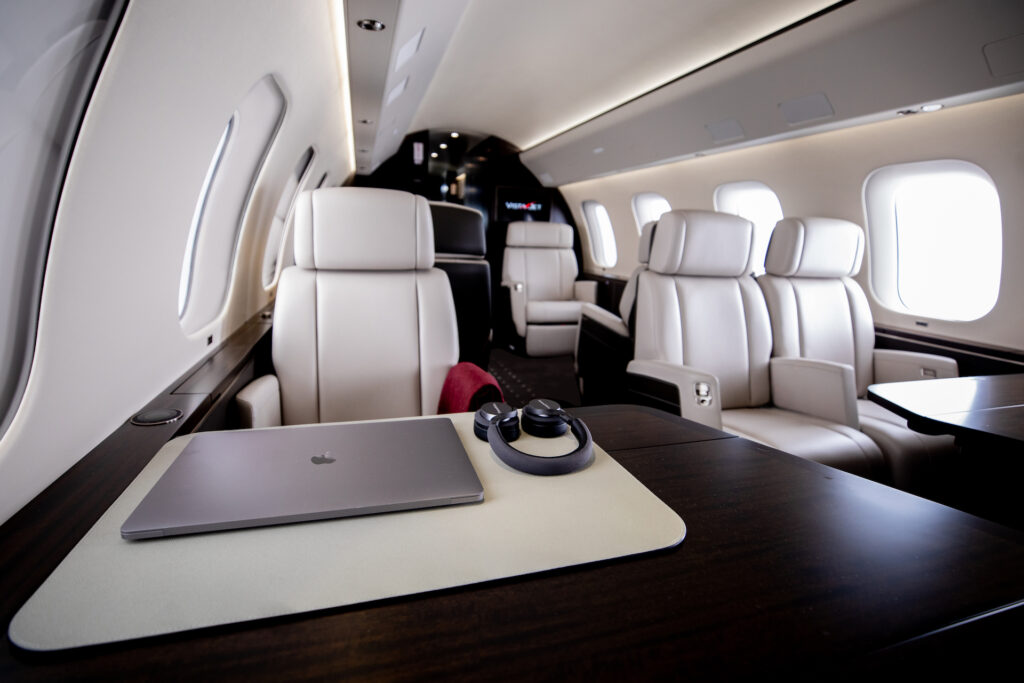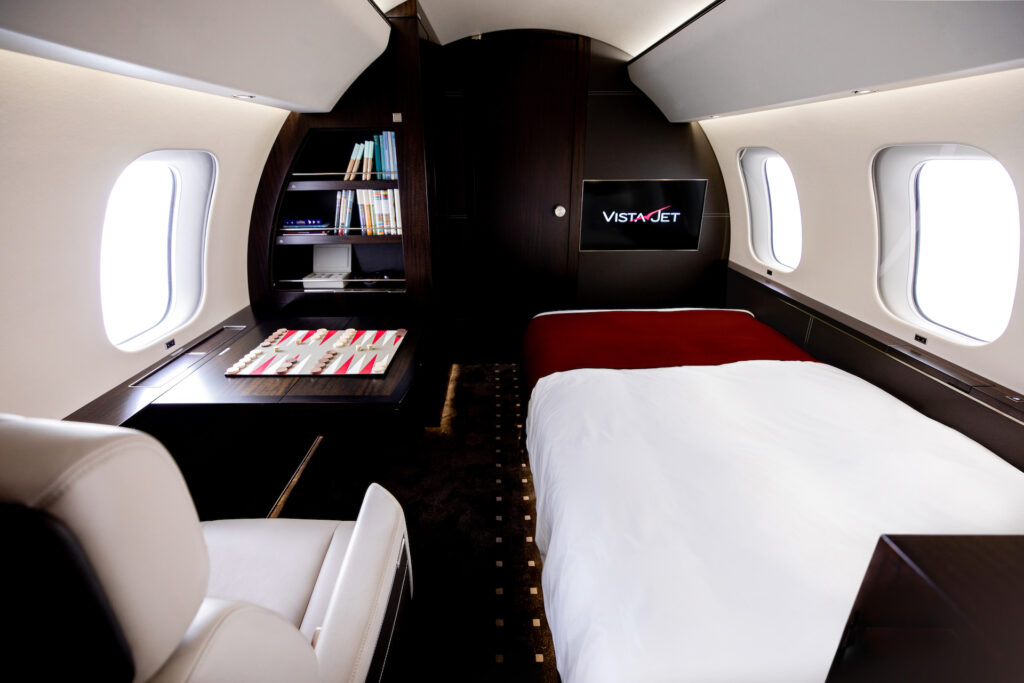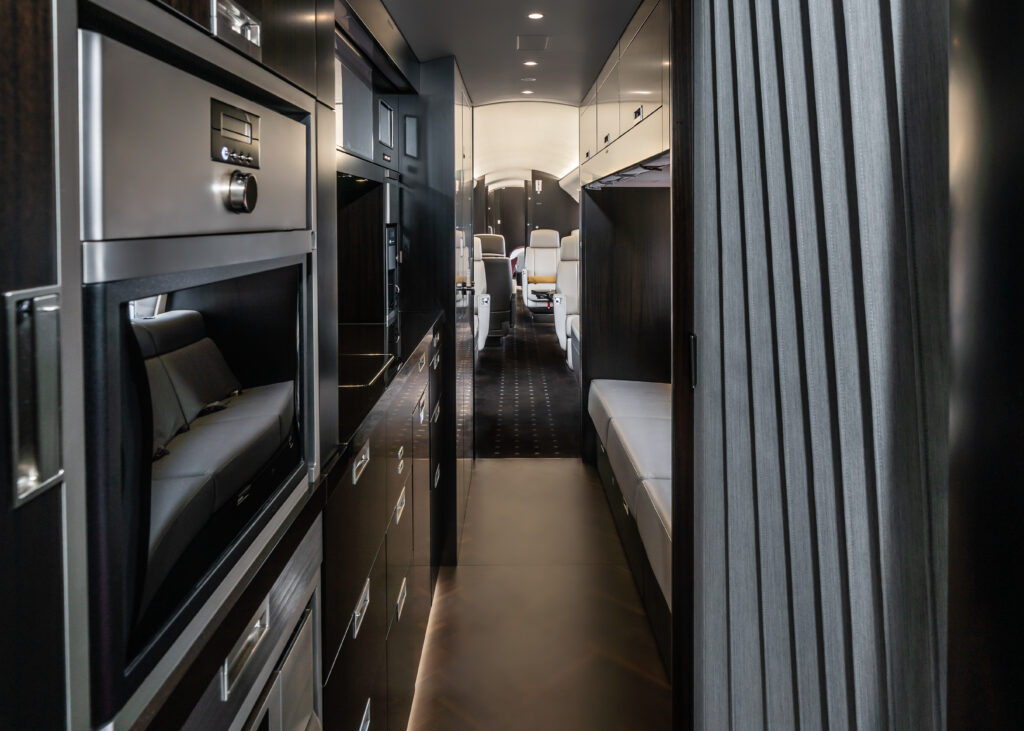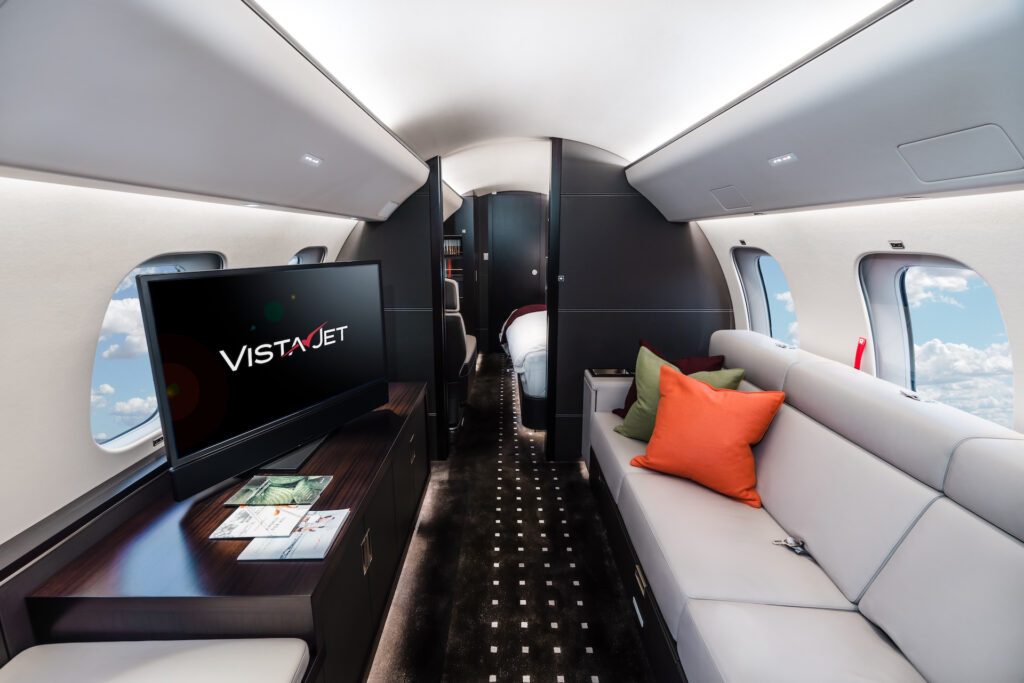Founded in 2004 by Swiss entrepreneur and investor Thomas Flohr, Vista Global has emerged as one of the… The post VistaJet US President Leona Qi on how the executive jet firm conquered the US appeared first on AeroTime.
Founded in 2004 by Swiss entrepreneur and investor Thomas Flohr, Vista Global has emerged as one of the major players in the executive aviation scene during the last couple of decades.
Vista Global operates under two brands, VistaJet and XO, which, while complementing each other, also cater to different segments of private flyers.
VistaJet is the group’s executive jet operator, focusing on the super-mid to long-range segment of the market. It operates its own fleet of 360 aircraft and takes pride in its ability to provide on-demand service to its members anywhere in the world.
XO is a service that makes it possible to book private jet flights with a number of pre-approved third-party operators.
Unlike the large United States (US) fractional jet operators, which are its main competitors, Vista started up in Europe and expanded its geographical footprint one continent at a time. Quite remarkably, it waited for more than a decade before establishing itself in the US, the world’s largest and most mature executive jet market by far.
However, after gaining a foothold in the US, things moved pretty fast. Seven years later Vista’s US operation accounts for half of the group’s customers .
The person behind this rapid growth is Leona Qi, who took over the role of President US at VistaJet in 2018, after having previously led Vista’s equally fast Asian expansion.
A Princeton University graduate, Qi began her career on New York’s Wall Street. There, she became an expert in the structuring and sale of asset-back securities, that is financial securities backed by real assets, such as aircraft.
She then went on to found Global Jet Capital, together with two partners. The firm, which still exists today, helps executive jet operators structure the financing of new aircraft acquisition. It was during her time at Global Jet Capital that Qi became familiar with Vista, eventually joining the executive jet firm with the mission to develop its business in Asia.
After managing to grow that business, which tripled in size over a period of two-and-a-half years (a frantic period in which she was commuting twice a month between New York and Vista’s Hong Kong office), Qi accepted the challenge to oversee Vista’s expansion in the US.
What pitch did Qi use to carve market share for Vista in such a competitive market?
“One thing that is unique about VistaJet is that we are the only truly global executive jet operator,” Qi said. “It is very important for us to have a footprint in every corner of the world.”
She noted that while Vista has some formidable competitors in the US, such as fractional jet operator NetJets, they do not carry as much weight in other parts of the world.
“Large US operators have tried expanding outside America multiple times, only to fail, retreat, and try again later with the same results,” Qi said. “We did it the other way around. We consolidated first our position everywhere else and only then we went for the American market.”
VistaJet is the group’s flagship product, offering what Qi refers to as “ownership replication”. This means that instead of owning your own jet or a fraction of it as proposed by a fractional operator, when signing up for VistaJet’s subscription service, you get the benefits of ownership without the burdens.
But how does this work? When you sign up, you commit to contract a minimum number of hours on a specific type of aircraft over a period of three years. This gives you guaranteed access to the use of the Vista Members’ fleet anywhere in the world, 365 days a year (as long as you provide 24-hour advance notice).
Consistency in the customer experience is one of VistaJet’s core tenets, so this also takes away another element of uncertainty. VistaJet has a standard cabin design across its whole fleet, so clients know exactly what the plane will be like, wherever in the world they board it, even if the airframe and crew is different each time.
“Our American customers value this product consistency a lot when they travel around the world,” Qi explained. “If you are a member, you have the same experience and the same hourly rate everywhere, globally.”
Then, there is also the financial dimension, an area of expertise that Qi knows perfectly well from her years of experience dealing with asset-backed securities.
“We offer a truly asset free solution. Our clients are not buying an asset with a cash flow that is complicated to predict,” she said. “If you own an aircraft, an important factor is when are you going to be able to sell it and for how much.”
“With fractional ownership you don’t even have a choice, whether you exit within three to five years, your provider tells you how much the aircraft is worth. Most of the time that is around 50% of the value it had when you bought it and you then have to pay also a 7.5% remarketing fee,” she explained. “With VistaJet you are subscribing to a number of hours per year for a number of years. The overall cost is comparable, but you can accurately forecast how much you are going to spend annually. We provide a very transparent pricing model.”
Qi went on to compare VistaJet’s model with outright ownership of an aircraft.
“We offer a fixed hourly rate anywhere in the world 365 days a year, no blackout days. You have an aircraft available with as little as 24-hour call-out, with flexible cancellation,” she explained. “It is better than ownership in that we guarantee aircraft availability 365 days of the year. If you own one aircraft, there are going to be some down periods, for example, while it is being serviced.”
She continued: “There may be some missions that it cannot fulfill due to lack of range, let’s say, if you have a Challenger 350 it will not be able to take you from New York to London. Or you may have a long range Global 7500 but using it to fly from London to Saint Tropez can be excess. With us you get the most mission effective aircraft at the most efficient rate, and it is always available.”
Not unexpectedly, service excellence also takes a prominent role in VistaJet’s value proposition.
“We pride ourselves in providing a premium solution, the best-in-class cabin experience, provided by highly trained cabin crew, that follow a specific training program by the British Butler Institute, MedAire and Norland College, in Britain,” Qi said. “We provide a wine program, a kid’s program, a pet’s program. We want to make sure that our experience forms the ground to the sky remains consistent.”
Qi said she sees Vista’s other product, XO, as complementary to VistaJet. XO is a private jet charter platform, which she referred to as an “open fleet solution”. This means that unlike VistaJet, which only operates its own aircraft, XO sources the aircraft from a number of third-party operators.
“We work with operators that we have safety-vetted , with a combined fleet of 2,400 safety-vetted aircraft, from light jets to large cabin aircraft,” she explained. “Unlike with VistaJet, XO pricing fluctuates depending on supply and demand at the time of the request.”
The required financial commitment is lower than with the VistaJet product, so XO is also a sort of steppingstone to introduce the VistaJet product to potential future customers. In addition to the partners’ aircraft, VistaJet’s own aircraft are sometimes also made available on XO when demand conditions permit. And it also works the other way around. VistaJet Members who, due to changing personal or professional circumstances have less need to fly, can move on to XO while still enjoying some of the benefits of being in the Vista community.
In addition to flights, Vista offers a number of activities and experiences to XO members that cannot always be purchased with money. For example, during art fairs like Art Basel Miami, XO may provide exclusive access to certain events or offer the chance to mingle with artists and creators. Likewise, Vista’s long-running partnership with Scuderia Ferrari allows it to offer its customers a limited number of opportunities to access the Formula One paddock.
One of Vista’s distinctive features is its focus on Bombardier aircraft. Recent acquisitions have introduced other types into its fleet, but aircraft made by the Canadian manufacturer, like the Bombardier Global 6000 and Global 7500, capable of carrying up to 19 passengers more than 10,000 miles nonstop, are the backbone of Vista’s fleet.
“It is very difficult to make money in the lighter jet categories. If some operators do it is because they have sold that asset risk to their clients. If you get people flying for 30 min or 60 min it is very difficult to be profitable,” Qi explained. “If someone commutes between New York City and Washinton DC, this is not our client. This is not a segment of the market we are interested in, but if we are talking New York to Los Angeles or New York to London, that’s our client. This is where we can shine! We are international and we focus on in-flight experience. It is difficult to demonstrate our service in a 50-minute flight.”
Qi also referred to the lower barriers of entry in the light jet segment of the market, a factor that often exerts a downward pressure on prices, particularly during downturns. She noted how the long-range missions Vista specializes in and the much higher capital requirements of operating a fleet of $70-80 million jets protects the company from a pricing race to the bottom.
During the COVID-19 pandemic, the executive jet industry was the object of renewed interest and not just out of health concerns. With most airlines grounded around the world, or operating limited schedules, many high-flyers turn to private charters for the first time.
“Health and safety became a main concern during the pandemic,” she explained. “There were also fewer routes commercially available, so many that could afford it switched to us. Some people have since gone back to commercial aviation, but some have remained after trying it.”
She also referred to the latest generations of long-range jets Vista has been investing in, noting that the company is now able to offer ever longer nonstop segments.
“People are focused on wellbeing and, in this regard, the VistaJet Global 7500 has ground-breaking tech in terms of lighting, oxygen flow, cabin pressure…all of this helps you feel refreshed and ready to go when you land on the other side of the world.
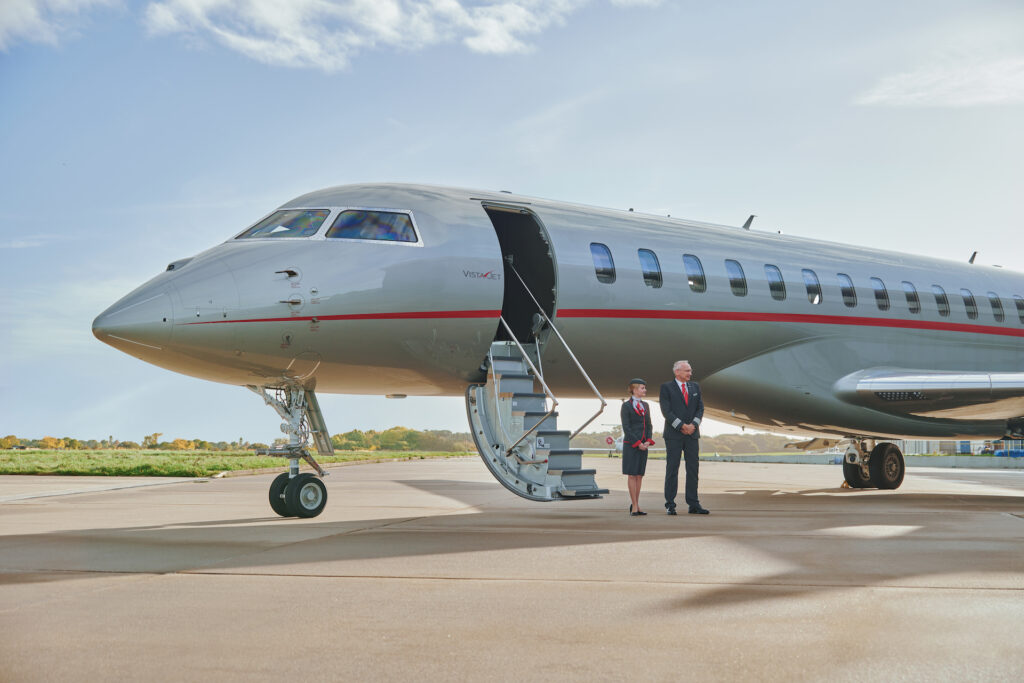 VistaJet
VistaJet
“Diet can also help fight jet lag and this is why we also provide dietary advice and top-notch food onboard,” she added. “But overall, the most valuable resource is time. This is something you cannot buy with money, but we can save you time, maybe even 20% sometimes.”
When talking about executive aviation it is impossible to avoid the growing concern about sustainability and environmental concerns. Executive aviation in particular has been the subject of criticism, especially among climate activists. What does Qi have to say about this?
“Sustainability is the biggest topic not just in private aviation, but everywhere,” she said. “The IATA [International Air Transport Association] requires all airlines to be carbon neutral by 2050 but at VistaJet we want to do so by 2025.”
She continued: “We have worked with South Pole [a provider of carbon offset solutions – ed. note] to launch a carbon offset program. 85% of our customers have opted in. We have also just launched a voluntary sustainable aviation fuel (SAF) program, allowing our customers to contribute this way too.”
While Vista is working on additional sources of SAF, it has also set its sights on future growth. The company completed two major acquisitions recently and it is now working to unify the fleet, paint the planes with its own branding and train and integrate the crews. Qi revealed that she expects most of the growth to continue to be organic.
“We will develop new programs and continue to work to understand our customers better and offering them the best possible product.” She said.
But, after years of growth, are there untapped reservoirs of premium travelers to tap? Is there a ceiling for executive aviation?
“There is a very long runway for private aviation to grow,” Qi said. “The US is the most mature market, with some 4,000 airports that can handle private jets, next is Europe with around 3,000. Compare that with around 400 commercial airports.
“And there are parts of the world that are still behind when it comes to executive aviation, also in infrastructure – the Middle East, Africa, India. In Asia-Pacific there is a very long runway for growth.”
There is no doubt that Qi expects Vista to play a major role in this growth story.
“We expect to become the world leader, both in terms of private aviation growth as well as in terms of being advocates for this industry,” she concluded. “We are connecting all the continents together.”
The post VistaJet US President Leona Qi on how the executive jet firm conquered the US appeared first on AeroTime.



